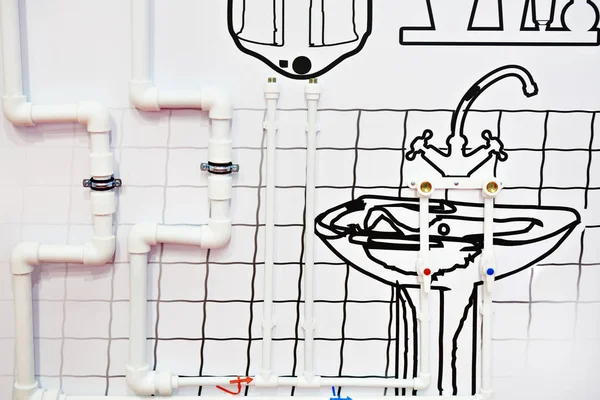(Images source: DepositPhotos)
When it comes to plumbing in new constructions, plumbers have a unique set of challenges and responsibilities. From choosing the right materials to planning a system that meets modern standards, there are numerous key factors that can make or break a project. Understanding these considerations can help plumbers streamline the process, avoid costly mistakes, and ensure long-term success.
This guide covers everything tradies need to know, from piping materials to building code compliance. Let’s explore the critical elements that plumbers should focus on when tackling new construction projects.
1. Choosing the Right Pipe Materials
Selecting the correct piping material is fundamental in new construction projects. Each type of piping has its own set of benefits and limitations, which can affect the overall efficiency and longevity of the system.
- PEX (Cross-linked Polyethylene): Increasingly popular for its flexibility and resistance to scale and chlorine, PEX is easier to install and more affordable than copper. It’s suitable for both hot and cold water supply lines, but choosing between PEX A, B, or C depends on availability, installer preference, and specific project needs.
- Copper: Known for durability and resistance to bacteria, copper piping is a traditional choice. However, it’s more expensive and can be prone to corrosion, particularly in areas with high water acidity.
- CPVC (Chlorinated Polyvinyl Chloride): While affordable and resistant to heat, CPVC is more brittle and less favoured due to potential breakages during installation. Many professionals recommend avoiding CPVC for new constructions in favour of more durable options like PEX or copper.
2. Understanding Building Codes and Regulations
Compliance with building codes and local regulations is non-negotiable for any new construction project. Plumbers must be familiar with:
- Water pressure requirements: Ensuring that systems provide adequate water pressure throughout the building without overloading the pipes.
- Backflow prevention: Preventing contamination by installing backflow preventers to keep harmful substances from entering potable water supplies.
- Fixture standards: Ensuring that all fixtures meet code, including flow rates for water-saving devices like faucets and showerheads.
Failure to comply with local codes can result in costly delays, fines, or even having to redo installations.
3. Efficient Layout Planning
The layout of a plumbing system can greatly affect both its efficiency and maintenance ease. When planning the system, consider:
- Minimising pipe runs: Shorter pipe runs reduce the chance of leaks and lower water heating costs. It’s beneficial to position plumbing fixtures close to each other.
- Wet wall placement: Placing extra-large wet walls in strategic locations allows for easier installation of piping and provides room for future maintenance or repairs.
- Cleanouts: Installing accessible cleanouts ensures that blockages can be quickly and easily cleared, minimising disruption for future repairs.
Proper layout planning is essential for creating a system that functions efficiently while minimising long-term maintenance issues.
 (Image source: DepositPhotos)
(Image source: DepositPhotos)
4. Water Heating Systems
[New constructions often call for innovative and efficient water heating solutions. Some popular options include:
- Tankless water heaters: These offer on-demand hot water, reducing energy costs, but may require more upfront planning for placement and proper ventilation.
- Solar water heaters: For eco-conscious builds, solar water heaters are an attractive option. Plumbers must ensure the system integrates smoothly with the rest of the plumbing and is positioned optimally for solar gain.
Regardless of the system chosen, proper sizing and installation are critical to ensuring reliable and consistent hot water supply.
5. Drainage and Ventilation Considerations
Plumbing isn’t just about delivering water; removing wastewater efficiently is equally important. Here are some drainage system considerations:
- Cast iron vs. PVC for drains: While PVC is more affordable, cast iron piping is quieter, fire-resistant, and more durable. It’s often the better choice for high-traffic or noise-sensitive areas like apartments or commercial buildings.
- Ventilation: Proper venting is crucial to avoid slow drains and sewer gas backups. Ensuring that the plumbing system is correctly vented helps maintain steady water flow and prevents unpleasant odours from escaping.
6. Insulation and Winter Proofing
If the new build is in a colder climate, insulating pipes to prevent freezing is essential. Key strategies include:
- Pipe insulation: Use foam or rubber pipe insulation to cover exposed pipes, particularly in unheated areas like basements and crawl spaces.
- Frost-free spigots: These are critical for preventing outdoor plumbing fixtures from freezing during colder months.
Planning for cold weather upfront can prevent burst pipes and costly repairs down the line.
 (Image source: DepositPhotos)
(Image source: DepositPhotos)
7. Collaboration with Other Trades
New constructions require collaboration between multiple trades. Plumbers must coordinate with builders, electricians, and HVAC specialists to ensure that the plumbing system is compatible with the building’s design and other systems.
- Utility tunnels: For larger commercial projects, some builders create separate utility tunnels for plumbing, electrical, and HVAC systems. This compartmentalisation can make maintenance easier and reduce the risk of damage.
By working closely with other trades, plumbers can ensure smooth installations and prevent conflicts during the build process.
Plumbing for new constructions involves more than just laying pipes—it's about careful planning, adhering to codes, and choosing the best materials and techniques for long-lasting, efficient systems.
Are you a plumber looking to expand your business? Listing your services on ServiceSeeking.com.au can connect you with more clients and projects. Start growing your business today by joining our platform!
